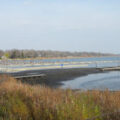[ad_1]
The physical setting of lakes, which includes underlying geology, elevation and surrounding land use, is the most significant driver of lake-level changes in the Twin Cities, according to a U.S. Geological Survey study published today.
Scientists with the USGS analyzed 96 lakes in the northeast metropolitan area of Minneapolis and Saint Paul, Minnesota, to determine why water levels recently declined in some, including White Bear Lake, yet increased in others. They found that not all lakes in the area respond similarly to weather and groundwater pumping, and White Bear Lake is especially sensitive to lake-level changes because of its unique deep-water outlets.
“Water-level changes in White Bear Lake have been the largest of the northeast metro lakes monitored since 1925,” said Perry Jones, a USGS scientist and lead author of the report. “Our study showed that water is flowing out of the lake at deeper depths, and this may be contributing to larger water-level changes.”
The scientists studied lake levels during short-term (2002–2010) and long-term (1925–2014) periods, and compared them to landscape and geologic characteristics, climatic factors and local groundwater withdrawals. The study found that:
- Closed-basin lakes, or those lacking an outlet like White Bear Lake, had more significant lake-level declines than flow-through lakes with an outlet;
- When closed-basin lake levels increased or decreased, groundwater levels reflected those changes;
- Water levels in flow-through lakes varied more when annual precipitation fluctuated;
- Lake-level declines were larger in higher-elevation areas; and
- The installation of water-flow control structures, such as culverts and weirs, helped moderate multiyear lake-level changes.
The study also showed that groundwater enters White Bear Lake from shallow sites near the shore, and leaves from deep-water sites at the bottom of the lake. When water flows out from these deep sites, it flows into aquifers beneath White Bear Lake. These deep-water outflows are uncommon in Minnesota lakes, and make the lake uniquely sensitive to water-level declines.
The USGS partnered with the Metropolitan Council and the Minnesota Department of Health on the new study.
For more information about water research in Minnesota, please visit the USGS Minnesota Water Science Center website.
[ad_2]
Source link
- Warmer water could cool Montana’s trout fishing economy - September 7, 2022
- Water Released from Crystallizing Magma can Trigger Earthquakes in Yellowstone - September 5, 2022
- Thermal Infrared Remote Sensing at Yellowstone 101 - August 29, 2022




